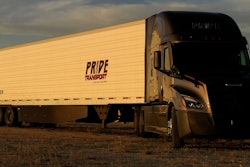The labor market has experienced a seismic shift in the last two years.
Supply chain interruptions, the global economy, rising inflation and changing worker experiences have impacted many industries that need workers, especially trucking. In 2021, the industry was short a then-record 60,000 drivers, and the ongoing challenge of hiring workers will not be short-lived. According to a projection by the American Trucking Associations, the industry is set to face a shortage of 160,000 drivers by 2030 if changes are not made.
At a time when four generations of drivers are active in the workforce and there are nearly two open jobs for every unemployed worker in the United States, organizations are competing for labor unlike ever before. Transportation and relocation companies must consider all the ways prospective and current drivers across generations interact with the business, from application to interview, hiring and onboarding.
In addition to the current driver shortage, strong growth in corporate relocation budgets and a competitive market for household moves highlight why the need to engage, attract and retain the next generation of drivers is critical today. Investing in technological innovation, competing on compensation, advocating to expand the workforce and accommodating and adapting to different generational work styles will support the long-term health of the business and industry.
Invest in technological innovation
When it comes to driver recruitment, leveraging purpose-built recruiting software has become increasingly necessary. This is especially important for young adult drivers ages 18 to 25, a demographic that was identified by the American Transportation Research Institute’s (ATRI) Research Advisory Committee as a top priority in 2021, with a focus on how to best integrate younger adults into trucking career. Young adult workers value a quick and easy application process as well as a seamless interview and job offer experience. These preferences can be supported and strengthened by innovative recruiting technology. In fact, according to cross-industry data from Employ Inc., 45% of workers would not apply to an employer again if they had a bad candidate experience.
Timeliness is especially important as Top Echelon Network research shows that 40% of job candidates reject offers because another organization made an offer faster. In the past six months alone, 72% of recruiters have encountered candidates who have, at one time, received multiple offers at the same time, according to new data from Employ. Smart recruiting software is one way to significantly reduce interaction time with potential drivers as well as the time-to-hire. For example, Atlas Van Lines recently partnered with Tenstreet, and was able to reduce the average time it takes to bring new recruits on board from 88 days to 15 days. Streamlining the hiring process through purpose-built recruiting software not only addresses the preferences and expectations of job seekers today, but also allows new hires to begin driving sooner, filling a critical workforce gap.
Further, organizations must make it as easy as possible for drivers to use their services in an efficient and valuable manner. For the next generation of drivers, offering easily accessible, interactive software is crucial to recruitment and retention as these workers expect to have technology integrated into their work experience. Organizations must prioritize the adoption of technological solutions that allow drivers to have the information they always need at their fingertips. For all generations, the tools should not be cumbersome or difficult to learn and use. Continuing to invest in technological innovations that appeal to and support drivers across generations is key to hiring and retention today.
Compete on compensation
A desire for higher compensation is a key factor for many workers today. A new study from ATRI surveyed Millennials and Gen-Z drivers ages 21 to 30, and 40% said compensation was the most important factor when it came to choosing a career in trucking. Furthermore, 52% of American workers across industries believe they could make more money right now simply by switching jobs. Competing on compensation is critical for attracting and retaining drivers, especially at a time when there are so many jobs available, and workers are entertaining positions in other trade industries. Organizations that cannot compete on pay must think of other forms of compensation that can be accommodated. This may include a signing bonus, more paid time off, a bonus if you hit specific targets or a more flexible schedule.
Advocate to lower driving age limit
There are important legislation efforts that look to remove roadblocks to growing the pipeline of the next generation of drivers. For example, under current federal regulations, states can issue a commercial driver’s license to anyone 18 or older, but it prohibits truck drivers from crossing state lines until they turn 21, which is usually required for long-haul trucking. To address this, the new Safe Driver Apprenticeship Pilot Program allows drivers who are at least 18 years old, have a state-issued commercial driver's license, and a clean record, to drive on the interstate under the direct supervision of an experienced driver.
Transportation and relocation companies must support legislation that accommodates drivers under the age of 21 because it creates a larger talent pool and helps capture young drivers at the onset of their careers. This can be done by engaging with local representatives involved in transportation legislation, including members of Congress who sit on the United States House Committee on Transportation and Infrastructure, which oversees the U.S. Department of Transportation and the implementation of policies like the Safe Driver Apprenticeship Pilot Program.
Stand by principles and values
Finding new drivers in today’s competitive market is one challenge, but retaining those drivers is another. Many younger workers opt to engage with organizations that are socially responsible and aligned with their values. According to ATRI, 84% of younger drivers consider company culture important. They are also more likely to want to be a part of an organization’s value system and hold them accountable. Today, one-third of new hires leave jobs within the first 90 days due to misaligned expectations, poor onboarding experiences and a company culture that is not a fit. Organizations can showcase their value to prospects by explaining its values, vision, mission and culture, and consider doing so during each part of the process: recruiting, interviewing and onboarding. Transportation companies can also showcase their value in practice by listening to and acting on feedback from employees and agents, who each bring a unique perspective that, if considered, will strengthen the organization overall.
While the driver workforce is aging – and this is a major contributing factor to today’s shortage – there are many ways to simultaneously engage and support existing drivers, while implementing new strategies to attract and retain a new generation. Hiring and retaining workers is a challenge across industries, but investing in technological innovation, competing on compensation, advocating for policy change and highlighting the organization’s culture and values are key strategies to support the needs of the trucking industry today. By doing so, we will begin to overcome the driver shortage and build a stronger, more stable workforce moving forward.
Barry Schellenberg is president and COO of Atlas Van Lines, a leading mover and the largest subsidiary of Atlas World Group. He leads the company’s household goods division in the U.S., which includes corporate marketing, transportation services, revenue distribution, customer service, and more. Schellenberg brings more than 30 years of experience in operations, supply chain, strategic execution, and logistics to Atlas® and the transportation industry.













